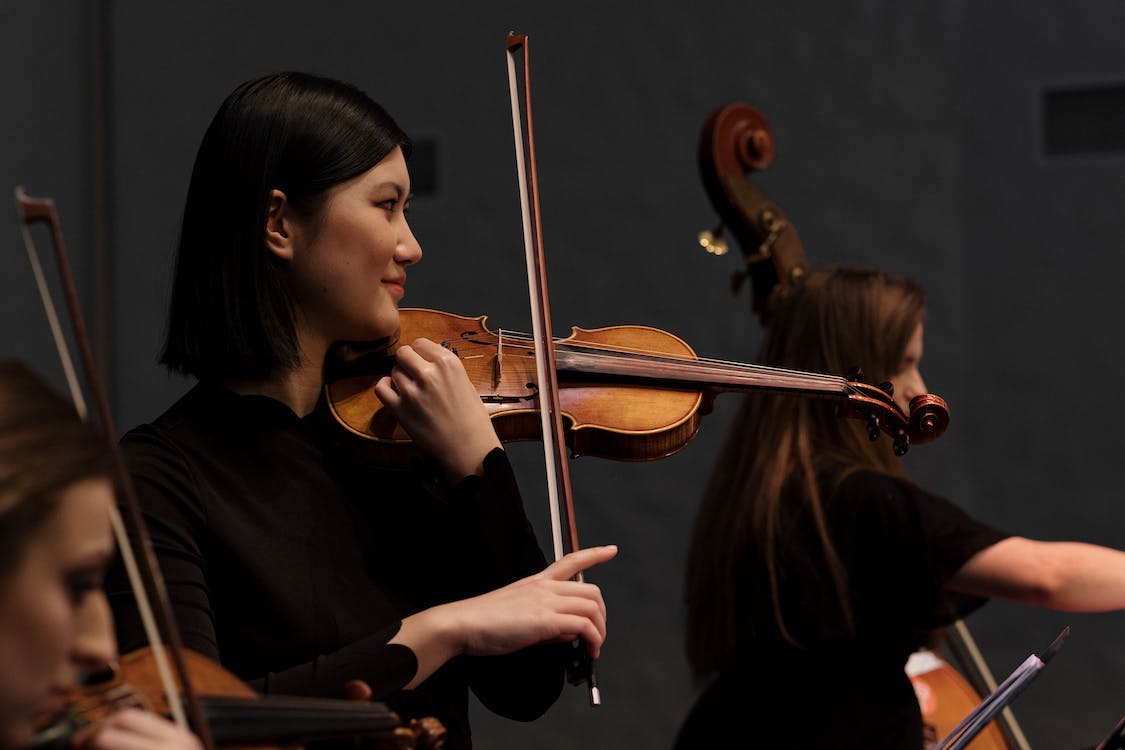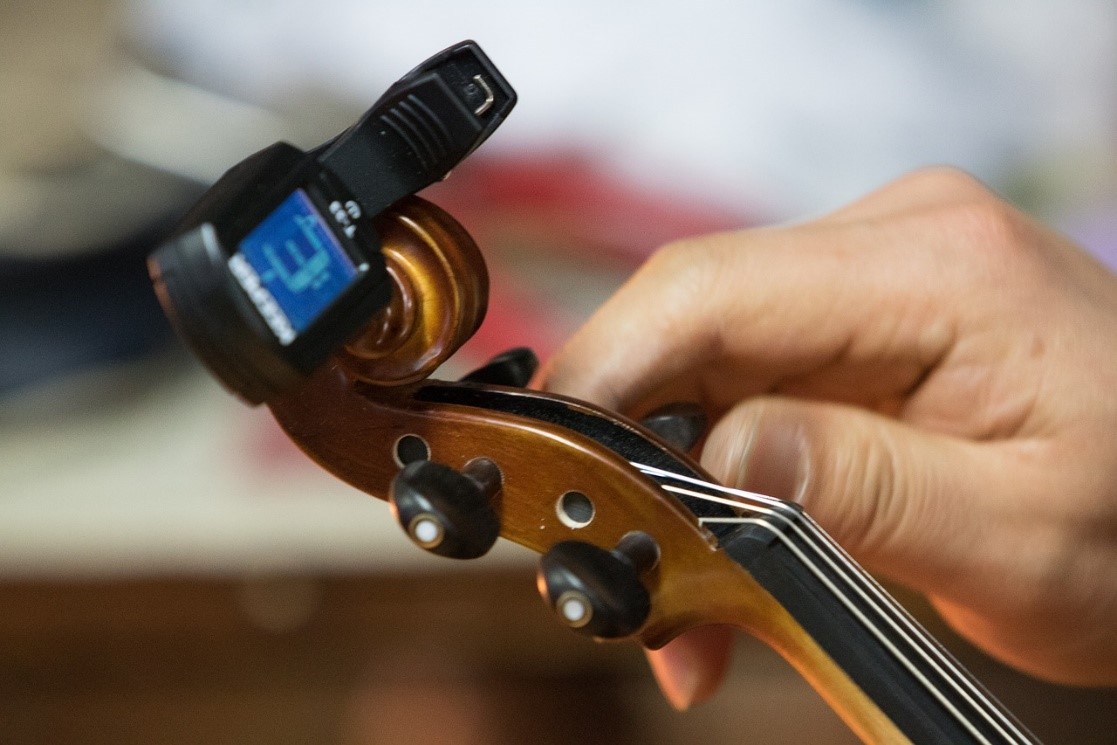
Tuning your violin, viola, cello, or double bass can be intimidating to the uninitiated. How do I tighten or loosen the strings without damaging them? What notes do I need to tune each string to? How will I know when I’ve reached the right pitch? Not to worry, we have you covered with tips on how to tune your string instrument! See our helpful tuning guides below.
Tuning Your Violin/Viola
Most violins and violas are fitted with friction pegs in the pegbox under the scroll. There are also fine tuners at the base of the tailpiece. Using these in combination will help you achieve perfect tuning.
The strings on the violin are, from lowest to highest (or left to right on the tailpiece), G, D, A, and E, or ‘GDAE!’ Gdae, mate! The strings on a viola from lowest to highest are CGDA, or ‘CGDA!’ This is less catchy than ‘GDAE.’
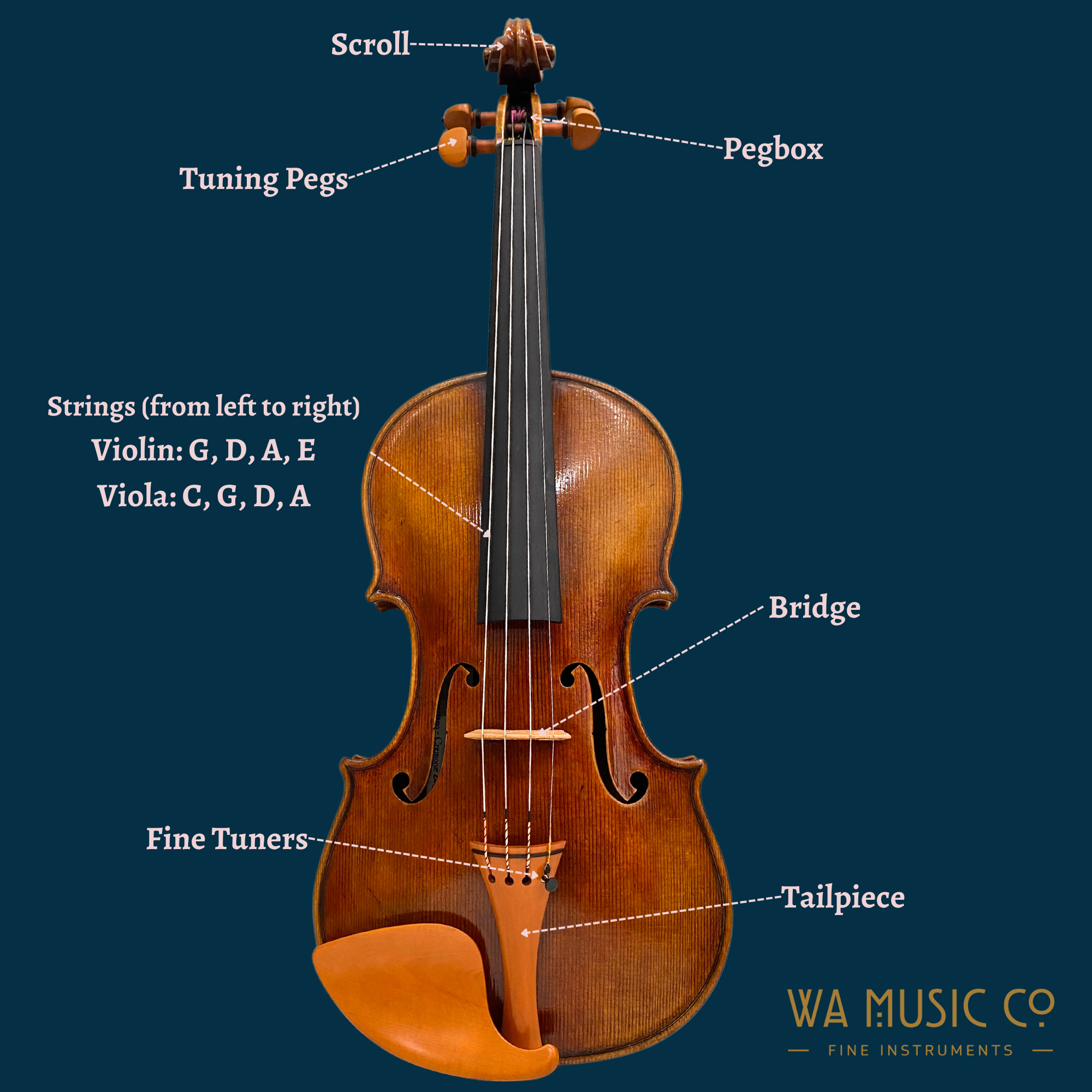
What Do I Need?
A tuning device will assist you greatly in the process of tuning your string instrument. Position your instrument close to your tuner of choice. You may own a chromatic tuner, or a clip-on tuner (Musedo Clip on Chromatic Tuner – WA Music Co), or you may have downloaded a tuning app on your phone. Many tuning apps for mobile devices are free and easy to use.
Tuning The ‘A String’
Start by plucking or bowing the A string. All orchestras tune to the note A, so this will get you in a good habit when it becomes time for you to tune in an ensemble setting!
If your A string is flat, locate the peg below the scroll. This will be the second on the right on a violin, or the rightmost/highest string on a viola. To raise the pitch of the string, gently grasp the peg and push in and twist up at the same time. These friction pegs hold their tuning according to how snug they are in their designated peg box hole. You should test the string after each push/twist motion to check where the pitch is sitting.
Friction pegs can be difficult to use and often require practice and experience to use effectively. Have a teacher, professional, or one of our friendly staff here at WA Music assist you should you need help tuning with pegs.
Using the fine tuners located on the upper end of tailpiece is much easier. These do not require the ‘push in and twist up’ motion of friction pegs. Screw the fine tuner clockwise to raise the pitch, and counterclockwise to lower it. When deciding how best to tune your string instrument as a beginner, fine tuners are the easiest way to tune up your violin, viola, or cello.
Rinse and Repeat
Repeat this peg and fine tuner process for the rest of the strings on the instrument. You may find that you need to readjust a string once more after an initial tuning. This is perfectly normal. Pluck two neighboring strings at once to hear the interval of a perfect fifth. If it sounds slightly ‘off’, you may need to adjust the pitch of one or both strings.
Double check the position of the bridge. During tuning, bridges have a tendency to lean forward as the strings are tightened. Have a teacher, professional, or the team here at WA Music to adjust the angle of the bridge if it looks to be leaning forward towards the fingerboard.
Having Trouble?
If you have any trouble at all tuning your instrument, don’t force it! We here at WA Music are more than happy to give you a hand. Bring your instrument to our store, and one of our friendly staff members would be happy to assist you.
Tuning Your Cello/Double Bass
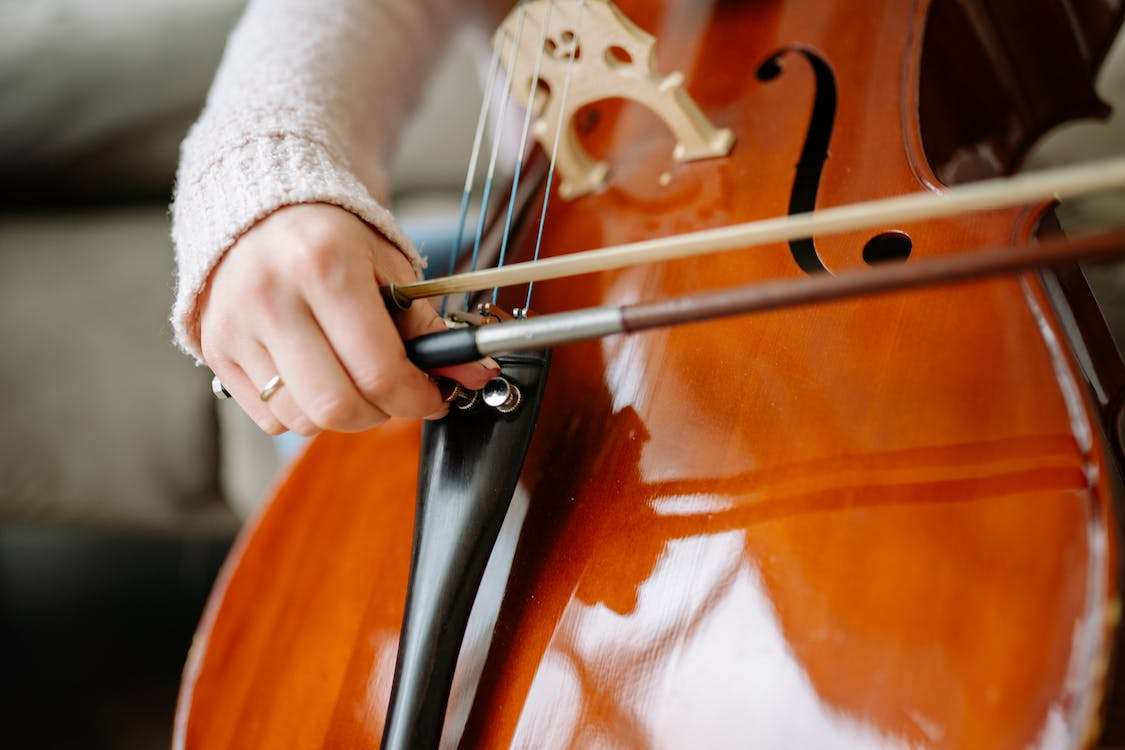
Friction Pegs or Geared Pegs?
Some cellos are fitted with geared pegs rather than friction pegs, while all double basses are fitted with a type of geared peg called a machine head. These pegs contain a geared mechanism that means for gradual and incremental turns and will not require the push in and twist up motion of a friction peg. If you are hiring a cello from us, you are guaranteed to have geared pegs on your instrument.
However, some cellos are fitted with friction tuning pegs. These will require the ‘push in and twist up’ motion of turning the peg. However, the tension, force, and torque of a cello string wound in a tuning peg is far greater than that of a violin or viola. These will require more strength, however, it’s important not to force the pegs during tuning. Friction pegs can be difficult to use and often require practice and experience to use effectively. Have a teacher, professional, or one of our friendly staff here at WA Music assist you should you need help tuning with pegs.
The strings on the cello, from lowest to highest (or left to right on the tailpiece) are C, G, D, and A. The strings on a double bass, from lowest to highest, are E, A, D, G.
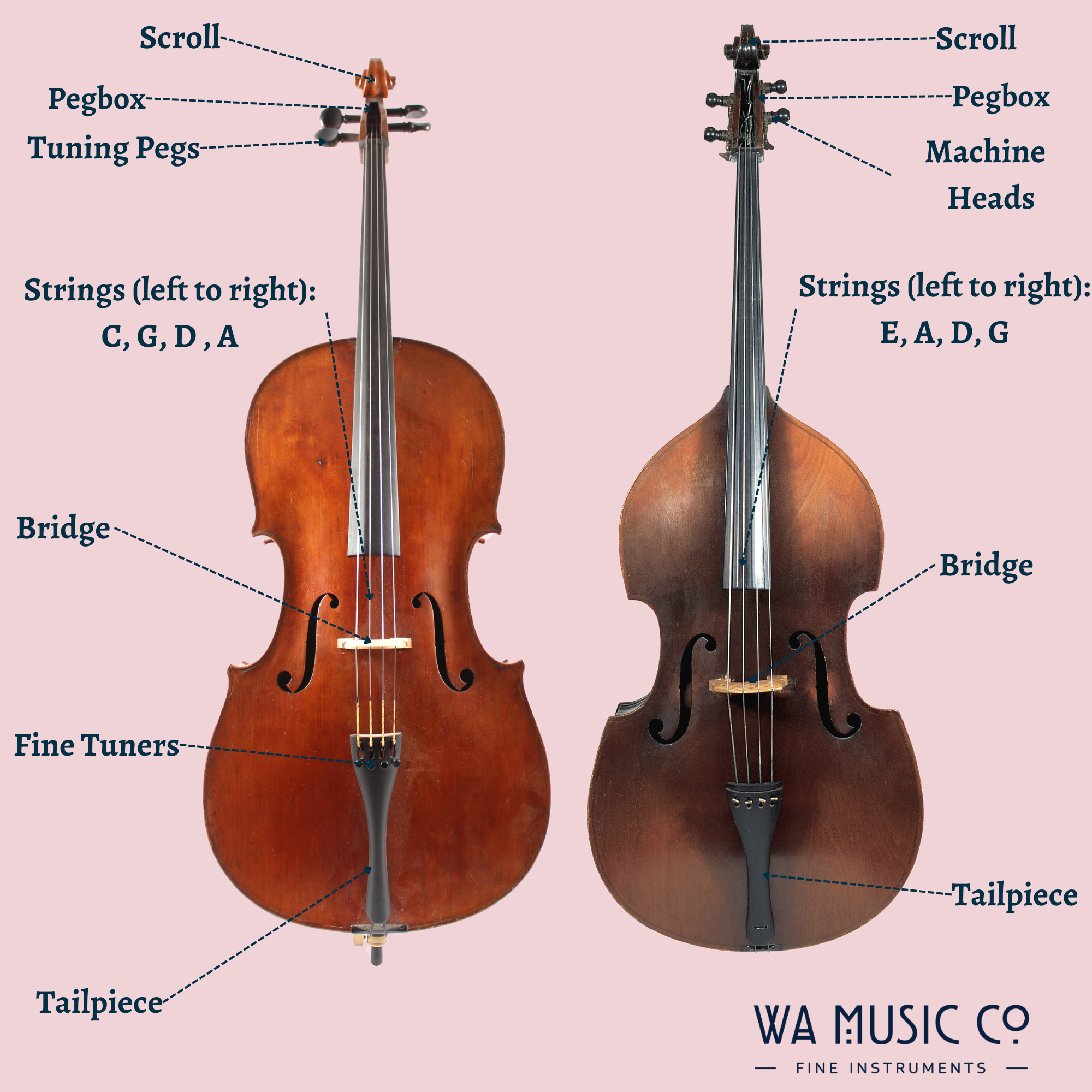
Tuning The ‘A String’
Start by plucking or bowing the A string. All orchestras tune to the note A, so this will get you in a good habit when it becomes time for you to tune in an ensemble setting!
If your A string is flat, locate the peg below the scroll. This will be the highest, thinnest string on the cello, or the second-lowest, second-thickest string on a double bass. To raise the pitch of the string, gently turn the peg. Geared pegs require little pressure during tuning, whereas friction pegs hold their tuning according to how snug they are in their designated peg box hole. You should test the string after each push/twist motion to check where the pitch is sitting.
Friction pegs can be difficult to use and often require practice and experience to use effectively. Have a teacher, professional, or one of our friendly staff here at WA Music assist you should you need help tuning with pegs.
Using the fine tuners located on the upper end of tailpiece is much easier. These do not require the ‘push in and twist up’ motion of friction pegs. Screw the fine tuner clockwise to raise the pitch, and counterclockwise to lower it.
Rinse and Repeat
Repeat this peg and fine tuner process for the rest of the strings on the instrument. You may find that you need to readjust a string once more after an initial tuning. This is perfectly normal. Pluck two neighboring strings at once to hear the interval of a perfect fifth. If it sounds slightly ‘off’, you may need to adjust the pitch of one or both strings.
Double check the position of the bridge. During tuning, bridges have a tendency to lean forward as the strings are tightened. Have a teacher, professional, or the team here at WA Music to adjust the angle of the bridge if it looks to be leaning forward towards the fingerboard.
Having Trouble?
If you have any trouble at all tuning your instrument, don’t force it! We here at WA Music are more than happy to give you a hand. Bring your instrument to our store, and one of our friendly staff members would be happy to assist you.
Common Tuning Mistakes for String Instruments
Snapping a string during tuning is common mistake and frankly, a rite of passage. Here are some tips to avoid damaging your strings, bridge, or instrument during tuning.
Over-tightening of the strings
Excessive tension on the string can lead to breakage, as can rushing the tuning process. Be sure to turn the peg incrementally and slowly to avoid over-winding.
Not using a tuner/reference pitch
Tuning by ear can be done with lots of practice, but tuning to a reference pitch or chromatic tuner will show you exactly where the note A is, and where the other strings should sit. You may get your strings in tune ‘relative’ to one another, but it’s important to make sure it’s in tune to established concert pitch too!
Not tuning frequently enough
You will have to tune your instrument before you play it, every single time. String instruments only hold their pitch for a limited amount of time; it’s important to be vigilante and double check your tuning before you play, even if you feel you’ve only just tuned. Consistency is key.
Not consulting a teacher or professional if unsure
If you are finding tuning a particular string or using a particular peg difficult, don’t force it! Have a string teacher or professional take a look at your instrument to avoid accidental damage to the instrument or the string.
Having Issues?
Feel free to contact us if you’re having any troubles with your instrument! We can be reached at (08) 9244 9559 for any questions you have, or you can email us at sales@wamusic.com.au. Alternatively, you can visit our friendly staff at WA Music Co., Shop 1/3 Morris Place, Innaloo WA 6018. We are more than happy to give you a hand!
Happy Tuning!
